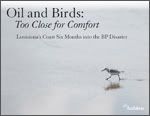It’s been over six months since the BP oil spill fiasco began. While media interest and coverage has reduced significantly since the leak was capped, there still remain numerous lingering effects on local habitat and wildlife.
I will be doing an interview about the potential impact on birds from the Boreal that winter or migrate through the Gulf on Monday at 12:15 EST on Radio Canada International’s The Link.

The effects of the spill on the Gulf Coast’s lush bird habitat is far from over.
Credit: Gulf Restoration Network
One of our Boreal Songbird Network partners, the National Audubon Society, has been active in monitoring bird habitat and behavior in the region since this tragedy began. Through its staff, members, and volunteers, Audubon has been on the ground to minimize adverse effects on birds and to ensure accurate information and data is available to the public. Most recently, they sent a team of scientists to conduct field surveys in the areas affected by the spill to produce a six month assessment of what’s going on.
Their findings were alarming, though not unexpected given the magnitude of this environmental disaster.
In nine out of ten areas deemed most impacted by the spill there were still notable quantities of oil, coming in various forms of surface oil, tar, tar balls and seepage coming from pockets inches under the sand or mud. This last form is perhaps the most hidden threat, as many beaches, salt marshes and estuaries that appear to be visually clean actually have layers of oil just inches below the surface. Many shorebirds will dig for insects and crustaceans along shorelines, meaning they could be dipping their bills literally into oil.

The Short-billed Dowitcher often probes sand and mud in search of food.
Credit: Jeff Nadler
Another cause for concern is that the majority of species they observed don’t seem deterred from going back to their traditional locations, regardless of the condition. Many migratory birds return to the same islands, beaches, salt marshes, and estuaries year after year and many resident birds have long-established habitats and breeding grounds – essentially meaning that oil or no oil, these birds aren’t going elsewhere, even if it’s at their own peril.
Audubon states that, as we’ve mentioned before, the largest threats to birds are long-term. Disrupting even the smallest of creatures can have long-lasting ripple effects on the whole ecosystem at large. As Audubon President and CEO David Yarnold puts it:
“People shouldn’t be fooled into thinking that the danger to birds and the environment is over just because the oil stopped flowing. It’s going to take years of monitoring just to understand and start dealing with the long-term impacts of the oil—and they’re just part of a much bigger threat.”
You can find out more about what the Audubon scientists observed in their press release and full report, downloadable below:


